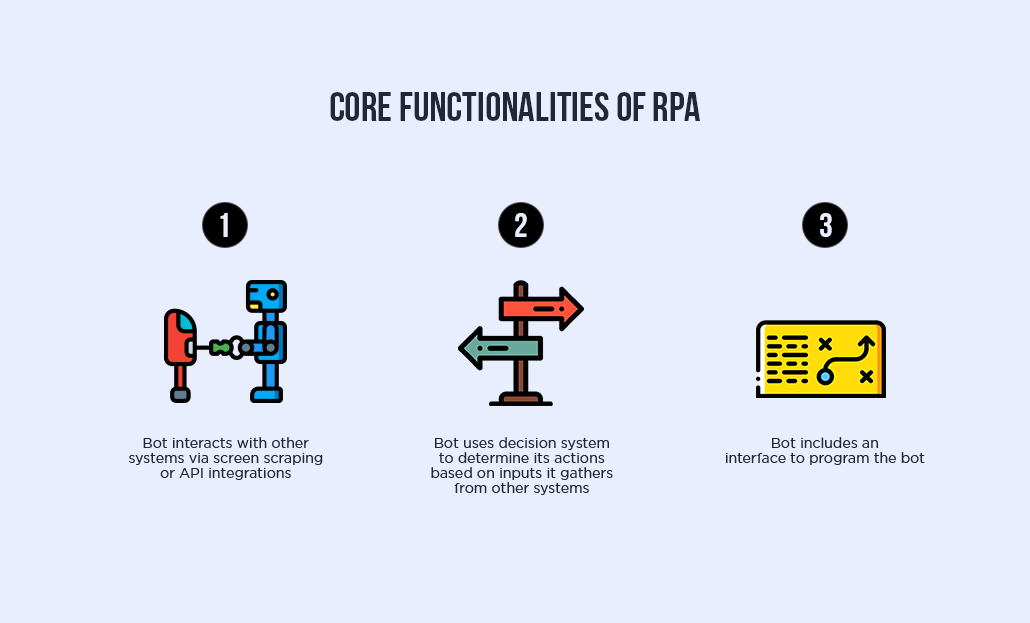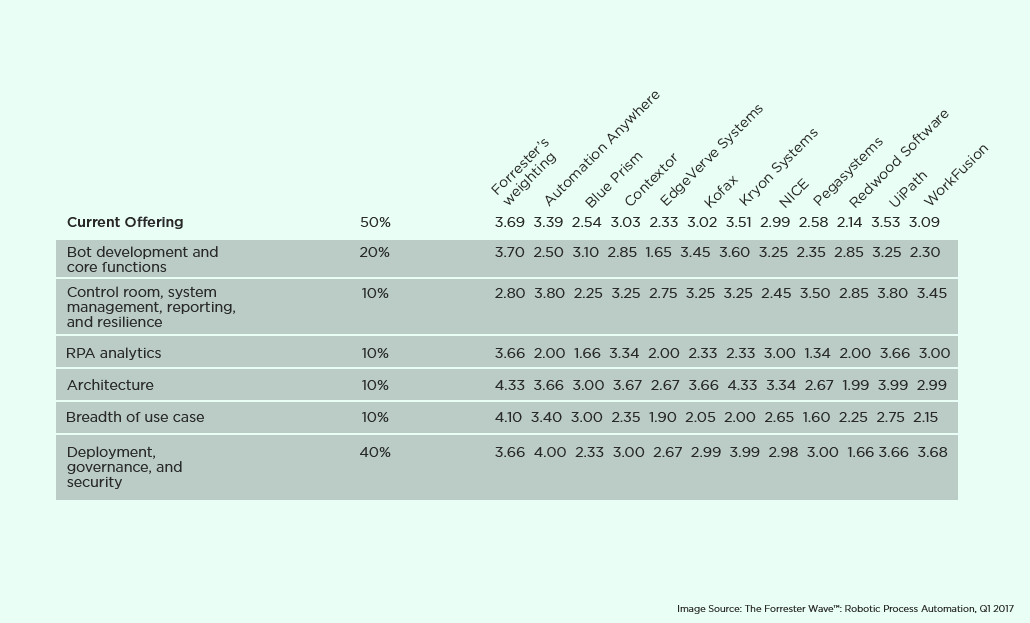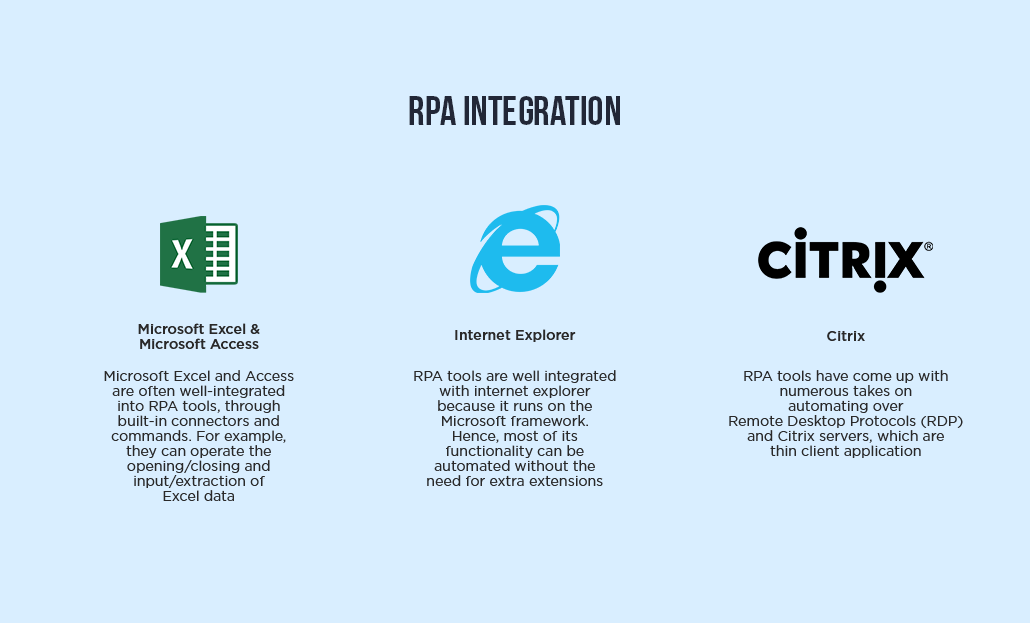Undoubtedly, the businesses today highly demand efficiency. Regardless of industry sector or market size, businesses search to leverage on efficiency to enhance productivity. One of the ideal ways to make business efficient and lean is adopting RPA (Robotic Process Automation) into business functions. Most businesses function on time-consuming, outdated, redundant functions, and processes like data entry and accessing files. Businesses that decide to automate these processes can save both money and time while enhancing productivity.
With the advent of RPA, new paths have been opened for the businesses to take over. Therefore, businesses should be smart enough to fetch the benefits of these opportunities. If you are planning to adopt an RPA solution, there are several RPA features to look for. This blog aims to present more about the capabilities of RPA tools that can support businesses to operate more efficiently.
Robotic Process Automation Tools – At a Glance
RPA tools use bots to automate the mundane tasks within the application typically performed by the employees of an organization. RPA robots are powerful enough to mimic several human user actions like log into applications, copy and paste data, move files and folders, fill in forms, scrape browsers, and extract structured & semi-structured data from documents.
The three core functionalities of the RPA are:

RPA enables seamless integration of front office bots and back office bots. The front office bots support to streamline, as well as simplify customer-facing functions like sales or customer services, whereas the back office software bots automate background or unattended functions. Examples of back office process include generating reports, transferring files or monitoring systems.
Know more about the benefits of RPA
Four Ways to Setup RPA Bots
- Programming the bot - The programming language is a powerful interface for implementing programming bots. However, it requires relevant technical skills to accomplish a successful setup. The programming instructions inform the robot which codes to use, and what the ways to communicate with the program are.
- Graphical User Interface - Most RPA vendors offer solutions to program bots with drag & drop interfaces. Even an employee with fewer technical skills can set up simple bots.
- Recording Macros – Like macros feature in excel, RPA bots can record actions. In addition, the recorded actions can comprise any number of enterprise software like the one fetches data from CRM and merging it with a report in excel.
- Self-learning bots – It is the easiest way to deploy the bots. This kind of bots observes recorded employee activities to identify automatable tasks with the assistance of a human. Once bots are implemented, an orchestration component supports to start/stop robots and evaluates their activities.
RPA Tools: Feature Spotlights
Robotic process automation is a broad field and there is a wide range of RPA tools in the market that considerably vary from each other. Their offerings are quite diverse along with its strengths and weaknesses. A report from Forrester on Robotic Process Automation compared the recent offerings of various RPA tools and offered RPA technology score, as shown below:

A detailed look on common features of RPA software:
1. Rich-Analytical Suite
RPA software comes with a rich-analytical suite that discovers the performance of the robot workforce. Most enterprise level RPA monitors and manages automated functions from a central console. This console can be accessed from anywhere and offer basic metrics on robots, servers, workflows, and more. The detailed operation analysis not only enables the users to track the operations and determine issues but it supports with streamlining future workloads. This solution of RPA requires no integration since everything is inbuilt and all set right out of the box.
2. Security
If an organization runs on automation, an abundant number of users will likely demand access to the RPA product. Here, it is crucial to have strong user access management features. Therefore, RPA tools include role-based security capability to ensure action specific permissions. In addition, many robotic process automation tools enable the configuration as well as customization of encryption capabilities for securing certain data types to defend against the interruption of network communication. The entire automated data, audits, and instructions accessed by the bot are encrypted to avoid malicious tampering and ensure the legitimacy of historical record compliance. Furthermore, the enterprise RPA solutions also offer detailed logging of users’ actions as well as each task executed. This feature assures internal security and maintains compliance with industry regulations like SOX, HIPAA or PCI DSS.
3. Simple Bot Creation Interface
RPA tools allow creating bots quickly and effortlessly by capturing mouse click and keystrokes with built-in screen recorder components. Many RPA products include the option to create and edit bots manually using the Task Editor.
4. Source Control
The method enables secure storage of each version of a process in progress without the risk of being deleted. The source control method enables developers to examine the difference between versions of a certain process to discover what has changed. Likewise, the control room component in some RPA products allows scheduling bots, handling bot’s versions, maintaining a log of user & bot activities, and administering users & roles. This component can offer auditable management as well as control over the RPA environment, including clients, bots, users, and schedules. It also equally performs as the single-point-of-access & control for bot implementation.
5. Hosting and Deployment Option
The RPA system is designed to offer a customer deployment across virtual machines, terminal services, and cloud. Among the other deployment options, the cloud deployment attracts the most customers for its scalability and flexibility. Adding to this, the RPA system is powerful enough to automatically deploy robots in groups of hundreds. This feature comprises an agentless configuration and proactively eliminates the central server synchronization problems and runtime updates by protecting client configuration as well as bot deployment overlap. Therefore, businesses can install RPA tools on desktops and deploy it on servers to access data for completing repetitive tasks. Similarly, they can also allow multiple bots to run different works within a single process while processing a high volume of data.
6. Rules-based Exception Handling
RPA system supports deployments with rules-based exception handling. This feature handles the exception in a proactive manner. Just consider a robot reports an exception, and then the following actions are triggered:
- The server re-assigns the same process to another bot for retry as well as remove the 1st bot from production.
- In case the retry is successful, the server maintains the reassignment and raises a level 2 alert to report exception & resolution.
- If the retry is unsuccessful, it stops the 2ndbot and raises a level 1 alert to report exception as well as failed resolution.
7. Debugging
The biggest benefit of RPA from a development perspective is its capability to go through a process and adjust dynamically. Some RPA tools require to stop running to make the change and replicate the process. Other RPA tools allow dynamic interaction while debugging. It also allows changing variable values to test different scenarios without start and stop the running. This dynamic approach of debugging allows to develop on the fly and to resolve issues in a production environment without requiring changes to the process.
8. Less Script or Script Less Automation
The modern RPA tools are code-free and can automate any application in any department where the admin or clerical work is performed across an enterprise. Hence, the employees with less programming skills can create bots, just through GUI and different intuitive wizards. This low-code or less code development platform reduces the amount of hand-code-writing and enables accelerated delivery of business apps. In addition, this platform lowers the initial cost of installation, training as well as deployment.
9. Seamless Integration
The core enterprise RPA integration is merging with the various 3rdparty applications in the digital infrastructure of businesses. With seamless integration, RPA tools provide unparalleled flexibility in evaluating the digital workforce performance. The following table depicts the most common integration in robotic process automation software:

10. Optical Character Recognition (OCR)
Outlining the optical character recognition in the RPA platform becomes a new trend today. Some RPA vendors begin expanding the capability of the RPA portfolio by taping advanced OCR to include simpler data extraction from documents and images. The most standard feature of RPA tool is screen scraping that deals with capturing bitmap data from the system screen and cross-check it against stored details to decipher it. This is attained by integrating with OCR engines like Google and Microsoft. In addition to text recognition, it possesses the capability to structure data while reading structured documents. Invoices, tax forms, claim processing, and rating generators are some document sets that make customer requires OCR with RPA initiatives.
11. Actionable Intelligence
The actionable intelligence feature of the RPA refers to the ability to gain and apply knowledge as skills. Robots that obtain both structured and unstructured data converts it into information and transforms the information into actionable intelligence for the end user or customer. The AI and cognitive intelligence are the common features of RPA solutions. They can involve machine learning, computer visions, and cognitive automation to help bots improve decision making over the period. Hence, most of its functionalities can be automated without the need for extra extensions.
Hope, this blog has provided you a sense of what RPA can do for your businesses. RPA features are worth looking at because they are transforming the world, apart from doing the great things for your business.
Don’t miss this informative whitepaper, “What Every Business Need to Know about RPA Bots?”





-8.png?width=375&height=240&name=BlogImage%20(1)-8.png)
